IELTS TUTOR cung cấp 🔥The Ethics of Driverless Cars Answers with location - Đề luyện IELTS READING- Làm bài online format computer-based, kèm đáp án, dịch & giải thích từ vựng - cấu trúc ngữ pháp khó
I. Kiến thức liên quan
II. Làm bài online (kéo xuống cuối bài blog để xem giải thích từ vựng & cấu trúc cụ thể hơn)
📩 MN AI CHƯA CÓ ĐÁP ÁN FORECAST QUÝ MỚI PART 1-2-3 NHẮN ZL 0905834420 IELTS TUTOR GỬI FREE HẾT NHA
III. The Ethics of Driverless Cars: Đề luyện IELTS READING (IELTS Reading Practice Test)
READING PASSAGE 3
You should spend about 20 minutes on Questions 27-40, which are based on Reading Passage 5 of the following:
The Ethics of Driverless Cars
A. The ethics of autonomous vehicles – those that effectively drive themselves without human intervention – that become a growing concern as such can start up among our public tools. This has proved an urgent need to address the constraints issues surrounding this developing technology before it becomes widespread. However, the issues raised are not easy to resolve, highlighting the frequent inadequacy of our current judgements and perhaps asking us to take responsibility for the pre-programmed needs for it machine.
B. The branch of knowledge which deals with most principles is known as ethics. Ethical concerns about autonomous cars are expected within an interdisciplinary field called “mber ethics” which brings together experts in engineering, computing, law, philosophy, sociology and psychology as these efforts serve to understand the implications of autonomous robots in human society. This reliability of machines can be level of decision-making authority they may have or key concerns and autonomous cars are a clear case of the predestination posed by this new technology.
C. The potential autonomous cars have to significantly increase road safety is not degraded. According to Bryant Walker Smith from the University of South Carolina, 90% of all traffic accidents are caused by human errors at least in part, and removing the human error causes world domination; reduce the number of those accidents. Another investigation, by leading management consultancy McKinsey & Co., found autonomous cars could save up to 30,000 times a year in the USA alone.>> Form đăng kí giải đề thi thật IELTS 4 kĩ năng kèm bài giải bộ đề 100 đề PART 2 IELTS SPEAKING quý đang thi (update hàng tuần) từ IELTS TUTOR
D. However, in order to eliminate the effect of human error, all vehicles would need to be fully autonomous. Yet it seems unlikely the public would accept a situation in which we relinquish all natural control vehicles, but only do very few people who maintain more than three hundred (despite all the evidence proving machines are safe). There is also the problem that putting the vehicle in complete and unsupervised contact information question about the level of the driver’s responsibility. This leads us to the ethical questions when ultimately responsible for the moral decisions programmed into and made by the vehicle we are, to a degree, controlling?
E. In September 2016, Germany was the first country to propose introducing a set of ethical principles for autonomous vehicles into traffic laws. The transport minister Alexander Dobrich suggested there, key rules for autonomous vehicles: firstly, when faced with imminent danger, autonomous vehicles must always choose to damage rubber than higher people. Secondly, the vehicles must cover distinguish between humans in any way, and most consider all the roads that come level of protection. Lastly, at all times there must be human overexisting the vehicle’s driving. This must be guaranteed by rendering the car manufacturer liable for any accidents which take place if nobody is holding the steering wheel.
F. Robot vehicles were quick to predict a scene from a line deal in proposal. While it is easy to see that car crashed crash into things too people, what should they tell him to choose between turning into one group of people over another? This thought experiment is usually called “The Trolley Problem,” that was first proposed by Philippe Focat in 1992. His relationships demonstrated that A mannequidity is hurtling down a mile away track towards five people who are tied to it. You are standing next to a lever which will make it totally if pulled back during two weeks that one person tied to the ground first. Do you push face-on? For, militiam users, which took off the other forces facing cars in the highway to pull the lever, killing one person behind of the Homeers, drivers are unlikely to welcome self-driving cars into rally militiam trucks, potentially leading to solutions in which the car chooses to wear their hairs and kill the other to save the lives of five pedestrians.
G. Bryn Casey graduated university courses in the Trolley Problem professor for autonomous vehicles, and holds that the problem is not even critical, but simply legal. It believes all points of contention will ultimately be used and resolved by the courts, and that argues that the programmer does not want to take a diagnosis for a shelter to an impossible and disprove some of human mortality. We keep the car within the business and continue to minimize injury, cars will inevitably be programmed to minimize legal liability for manufacturers. However this is why we must be agreed across the car industry and matters in its no possible to make the extensive testing out of the vehicles visible.
H. If the list is written in such a way that the autonomous car is held responsible for all injury and any damage caused by the autonomous car regardless of other considerations, scenarios will program the vehicles to eliminate situations of risk. Manufacturers such as Volvo and Google have already had a good job to improve responsibility for accidents involving their vehicles. Our reasons for this stem from an attempt to ensure the public’s trust in the technology, shifting some responsibility away from the customer in case of an accident. However, they would only accept responsibility due to a line in the vehicle, not when the technology was used inappropriately, or if the decisions was caused by a third party, if others follow their lead, some headway may be made in this legal restriction of responsibility, allowing for the undesirable spread of autonomous cars to continue its journey.
Questions 28–34
Reading Passage 3 has six paragraphs, A–H.
Choose the correct heading for each paragraph from the list of headings below.
Write the correct number, i–x, in boxes 28–34 on your answer sheet.
List of Headings
i. The likely solution
ii. The capability connections
iii. Lessons from history
iv. Guiding public confidence
v. A true problem on our roads
vi. The key benefit of driverless cars
vii. The accident dilemma
viii. An initial solution
ix. An unethical problem
x. A multi-faceted domain
[Example | Paragraph A | Answer: v ]
Paragraph B
Paragraph C
Paragraph D
Paragraph E
Paragraph F
Paragraph G
Paragraph H
Questions 35 and 36
Complete the summary below.
Choose NO MORE THAN TWO WORDS from the passage for each answer.
Write your answers in boxes 35 and 36 on your answer sheet.
The Trolley Problem
"The Trolley Problem" is a 35 ______ in ethics, first introduced in 1967 by Philippa Foot. The general form of the problem is: There is a runaway trolley hurtling down a railway line. Ahead, on the rails, there are five people tied unable to move. To avoid hitting them, the trolley can be switched to a 36 ______ to which one person is bound. You have two options: Do nothing, causing five deaths or divert the trolley causing just one.
What do you do?
Questions 37–40
Choose the correct letter, A, B, C, or D.
Write the correct letter in boxes 37–40 on your answer sheet.
German transport minister Alexander Dobrindt was mainly concerned with
A. getting driverless cars on the road in Germany as soon as possible.
B. making Germany’s cars more autonomous than other countries.>> IELTS TUTOR gợi ý tham khảo CẦN VIẾT & THU ÂM BAO NHIÊU BÀI ĐỂ ĐẠT 8.0 SPEAKING & 7.0 WRITING?
C. protecting human life.
D. reducing the number of road accidents in Germany.Before driverless cars become widespread,
A. global consensus on legal issues must be reached.
B. they need to be proven safe.
C. car manufacturers must accept all liability for accidents.
D. the public will have to have more faith in the software.Some automobile firms have already said they will accept liability for accidents involving their cars
A. providing there is nobody controlling the vehicle at the time.
B. in the event the vehicle itself was at fault.
C. to encourage other manufacturers to invest in the technology.
D. to pre-empt lengthy legal disputes.Which of the following best summarises the text as a whole?
A. Experts disagree on where the responsibility for driverless cars lies.
B. Driverless cars will create a safer world by eliminating driver error from our roads.
C. Important issues need to be laid to rest before driverless cars can become commonplace.
D. Robot ethicists will find the answers to the moral questions driverless cars raise.
IV. Dịch bài đọc The Ethics of Driverless Cars
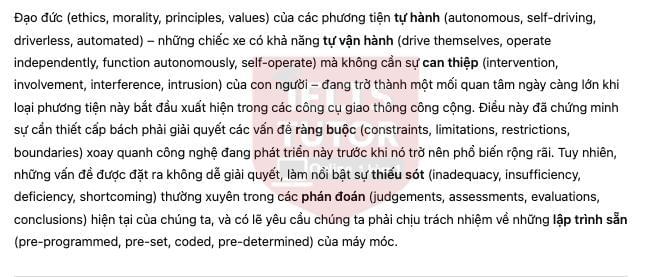
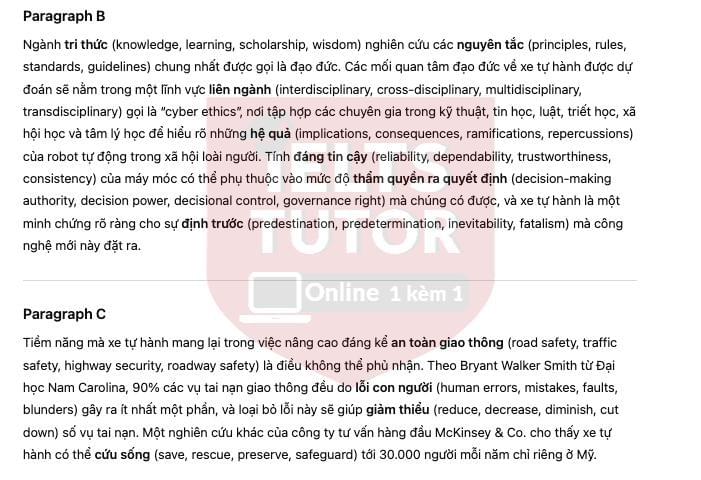


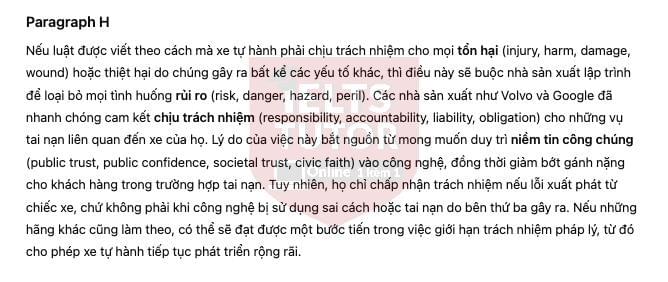
V. Giải thích từ vựng The Ethics of Driverless Cars
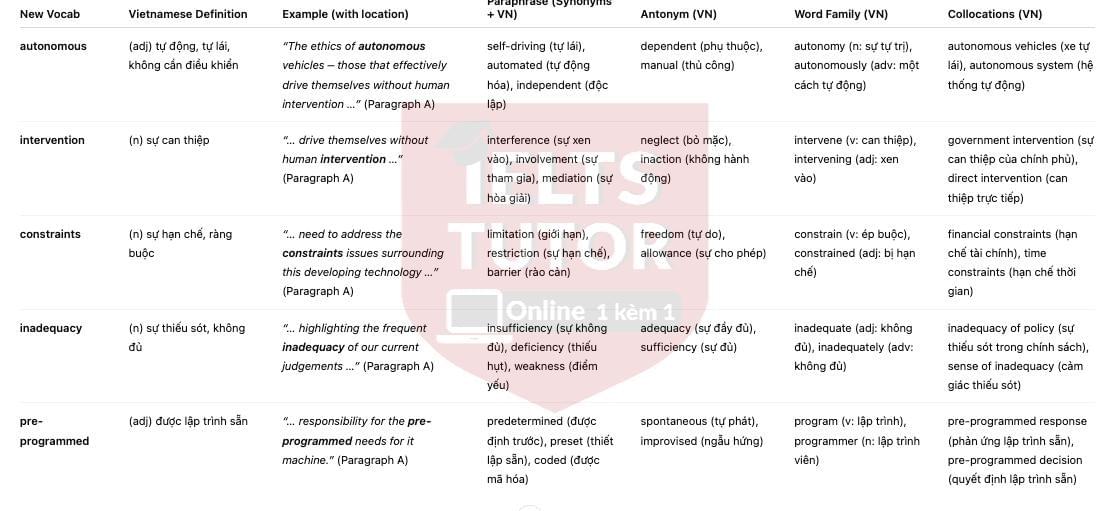
VI. Giải thích cấu trúc ngữ pháp khó The Ethics of Driverless Cars
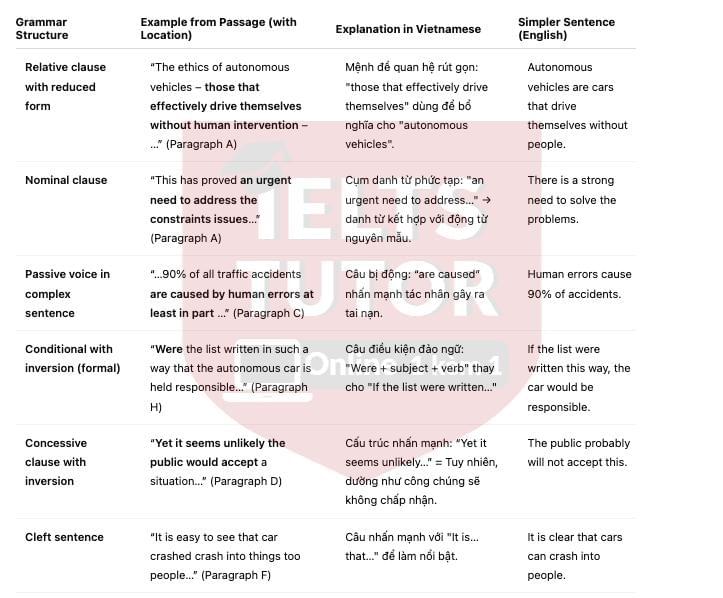
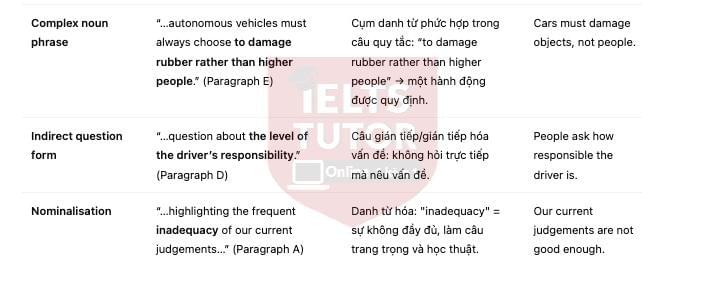
VII. Đáp án The Ethics of Driverless Cars
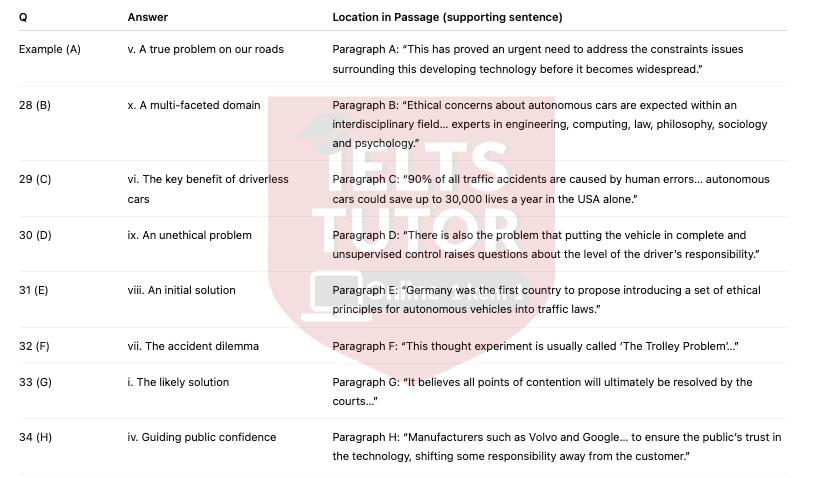
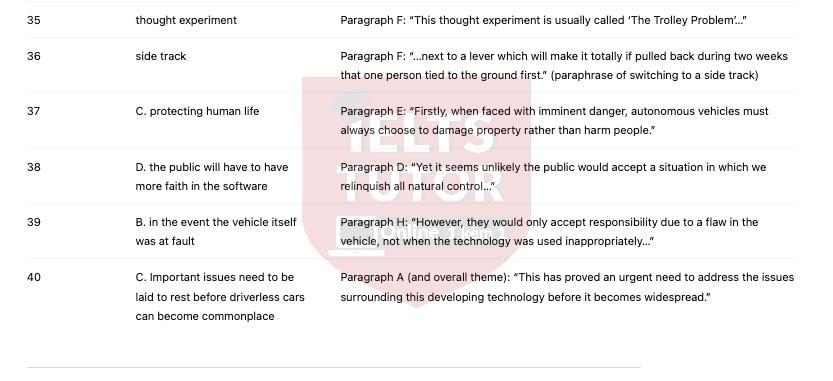
x
vi
ix
viii
vii
i
iv
thought experiment
side track
C
D
B
C
📩 MN AI CHƯA CÓ ĐÁP ÁN FORECAST QUÝ MỚI PART 1-2-3 NHẮN ZL 0905834420 IELTS TUTOR GỬI FREE HẾT NHA

Các khóa học IELTS online 1 kèm 1 - 100% cam kết đạt target 6.0 - 7.0 - 8.0 - Đảm bảo đầu ra - Thi không đạt, học lại FREE
>> Thành tích học sinh IELTS TUTOR với hàng ngàn feedback được cập nhật hàng ngày



